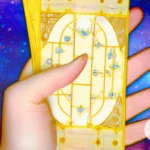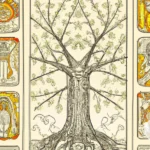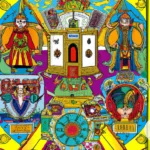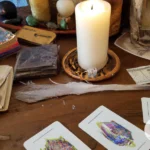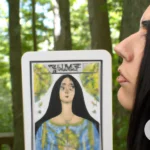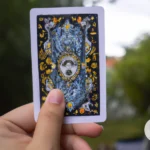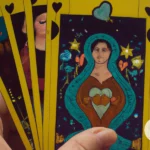Tarot decks have always fascinated people with their intricate symbolism and powerful imagery. The cards have been used for divination and self-discovery for centuries. However, many are unaware of the presence of Kabbalistic teachings in traditional tarot decks. The origins of tarot are shrouded in mystery, but it is widely accepted that Kabbalah played a significant role in shaping the cards we know today. This article seeks to explore the influence of Kabbalah on tarot and how this knowledge can enhance your tarot practice. Join me on a journey through the symbolic language of tarot and the mystical teachings of the Kabbalah.
The Symbolic Language of Tarot
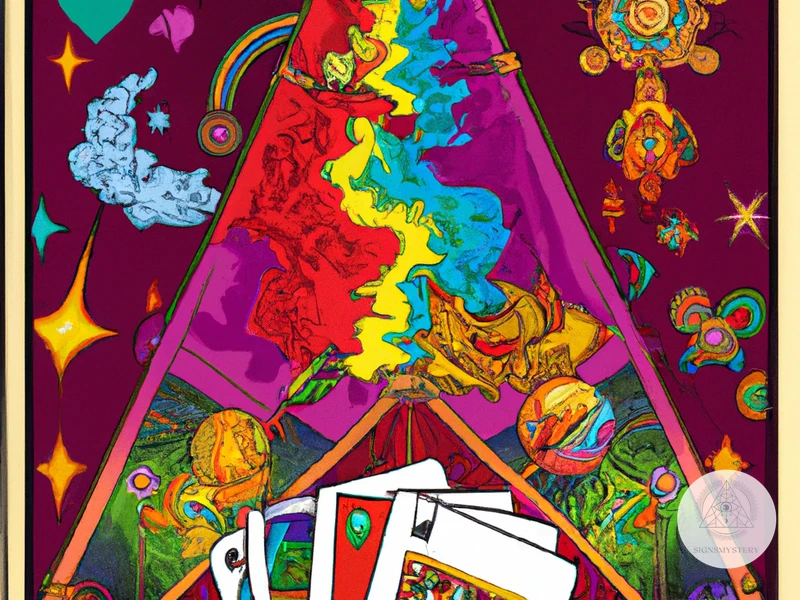
The tarot is a mystifying tool often associated with divination and fortune-telling. Its 78 cards, separated into Major and Minor Arcanas, are filled with intricate symbols that can be interpreted in a variety of ways. However, the symbolic language of the tarot is not just a product of random imagination, but rather a carefully crafted system with roots in ancient knowledge and esoteric traditions. Understanding the meaning and significance behind the symbols in tarot cards is crucial to unlocking their true potential. In this section, we will explore the symbolic language of tarot and examine its connection to kabbalistic teachings. To delve deeper into the world of kabbalah and tarot, you can check our guide on Tree of Life Tarot correspondences or read our article on Major Arcana and Kabbalah.
The Major Arcana
The Major Arcana of a tarot deck comprises the 22 trump cards that portray powerful archetypes with profound meanings. Each card conveys a message that signifies a journey of spiritual growth and self-discovery. The Major Arcana cards are heavily influenced by Kabbalistic teachings and correspondences.
The Fool: This card signifies the beginning of a journey, representing innocence, spontaneity, and childlike wonder. The Fool is associated with Keter, the first and highest sefirah in the Tree of Life.
The Magician: The Magician embodies manifestation, creation, and the power of the will. This card is often associated with the sefirah of Binah, the source of creativity and imagination.
The High Priestess: Also known as the Papess, this card symbolizes intuition, secrets, and the mysteries of the unconscious. The High Priestess is associated with the sefirah of Hokhmah, the realm of wisdom and understanding.
The Empress: This card represents creativity, abundance, and nurturing. The Empress is often linked to the sefirah of Malkhut, the physical world, and the divine feminine.
The Emperor: The Emperor is associated with structure, order, and authority. This card is often linked to the sefirah of Yesod, the foundation of the Tree of Life.
The Hierophant: Also known as the Pope or the High Priest, this card symbolizes tradition, conformity, and guidance. The Hierophant is associated with the sefirah of Hesed, the realm of loving-kindness.
The Lovers: This card embodies love, relationships, and choices. The Lovers are often linked to the sefirah of Tiferet, the center of balance and harmony.
The Chariot: The Chariot represents victory, willpower, and determination. This card is associated with the sefirah of Gevurah, the realm of strength and power.
Strength: This card signifies inner strength, courage, and overcoming challenges. Strength is linked to the sefirah of Hesed.
The Hermit: This card represents introspection, solitude, and wisdom. The Hermit is associated with the sefirah of Binah.
The Wheel of Fortune: The Wheel of Fortune embodies cycles, change, and destiny. This card is often linked to the sefirah of Netzach, the realm of victory and eternity.
Justice: This card signifies balance, fairness, and truth. Justice is associated with the sefirah of Din, the realm of judgment.
The Hanged Man: The Hanged Man represents surrender, sacrifice, and letting go. This card is often linked to the sefirah of Hod, the realm of intellect and learning.
Death: This card symbolizes transformation, endings, and new beginnings. Death is associated with the sefirah of Binah.
Temperance: This card embodies balance, harmony, and self-control. Temperance is often linked to the sefirah of Tiferet.
The Devil: This card represents addiction, materialism, and temptation. The Devil is associated with the sefirah of Geburah.
The Tower: The Tower signifies upheaval, chaos, and revelation. This card is often linked to the sefirah of Hod.
The Star: This card represents hope, inspiration, and guidance. The Star is associated with the sefirah of Netzach.
The Moon: The Moon symbolizes intuition, mystery, and the unconscious. The Moon is often linked to the sefirah of Yesod.
The Sun: The Sun embodies happiness, success, and vitality. This card is associated with the sefirah of Tiferet.
Judgment: This card signifies rebirth, renewal, and awakening. Judgment is often linked to the sefirah of Malkhut.
The World: The World represents completion, wholeness, and fulfillment. This card is associated with the sefirah of Malkhut.
Kabbalistic teachings provide a framework for understanding the profound symbolism of the Major Arcana cards. For more insights into the correspondences between tarot and Kabbalah, check out the article on Ten Sephirot and Tarot Meaning.
The Minor Arcana
The Minor Arcana cards in tarot decks represent everyday events and people we encounter in our lives. There are four suits in the Minor Arcana, each with its own symbolism and meaning. The suits are called Wands, Cups, Swords, and Pentacles.
Wands represent the element of fire and correspond to creativity, passion, and energy. It also has a strong association with the will and the ego. In Kabbalah, fire corresponds to the Sefirah of Netzach – victory, which represents the triumph of the spiritual over the material.
Cups represent the element of water and are associated with emotions, intuition and the unconscious. Cups represent the heart and reflect our feelings towards others. In Kabbalah, water corresponds to the Sefirah of Hod – majesty, which represents the act of accepting the limits of reality.
Swords represent the element of air and are associated with thoughts, reason, and communication. In tarot, swords are often depicted as double-edged, representing the balance and duality of each situation. In Kabbalah, air corresponds to the Sefirah of Yesod – foundation, representing the seat of our desires.
Pentacles represent the element of earth and symbolize material possessions and the physical world. Pentacles are often associated with work and finances, reflecting our practical and earthly concerns. In Kabbalah, earth corresponds to the Sefirah of Malkuth – kingdom, the ultimate manifestation of creation.
Understanding the Kabbalistic meaning behind each suit can enhance your tarot practice by adding a deeper layer of interpretation to your readings. Additionally, knowing the Kabbalistic correspondences of each Minor Arcana card can help you gain a more comprehensive understanding of the tarot deck as a whole.
If you want to incorporate Kabbalistic teachings into your interpretation of the Minor Arcana court cards, you can learn more about them by following this link. For a more in-depth analysis of how Kabbalah can enhance your tarot practice, check out our article on Kabbalah Tarot Enhancement.
Kabbalah: A Brief Overview
Kabbalah is a mystic and esoteric tradition that originated in Judaism in the late 12th century. The term Kabbalah literally means “receiving” or “to receive”. It is based on a complex system of symbolism that is used to understand the nature of God, the creation of the universe, and the purpose of human existence.
According to Kabbalistic teachings, the universe is divided into four levels or worlds, each with its own characteristics and attributes. These levels represent different stages of manifestation from the highest level of divine consciousness to the lowest level of material reality. The four worlds are Atziluth, Briah, Yetzirah, and Assiah.
Kabbalah also teaches about the ten Sefirot, which are attributes or emanations of God. The Sefirot are arranged in a hierarchical system that corresponds to the levels of reality in the four worlds. They are: Keter (Crown), Chochmah (Wisdom), Binah (Understanding), Chesed (Mercy), Gevurah (Strength), Tiferet (Beauty), Netzach (Victory), Hod (Splendor), Yesod (Foundation), and Malkuth (Kingdom).
In Kabbalistic philosophy, the journey of the human soul is to ascend through the levels of the four worlds, ultimately reaching unity with the divine. Kabbalistic teachings also provide a system of meditation and contemplation that helps individuals to connect with the divine and uncover the mystical secrets of the universe.
Kabbalah is a complex system of thought that has inspired many spiritual traditions and has had a significant influence on Western esotericism. Its teachings have also played a profound role in the development of esoteric Tarot, which draws heavily on Kabbalistic symbolism to convey its meanings.
How Kabbalah Influenced Tarot
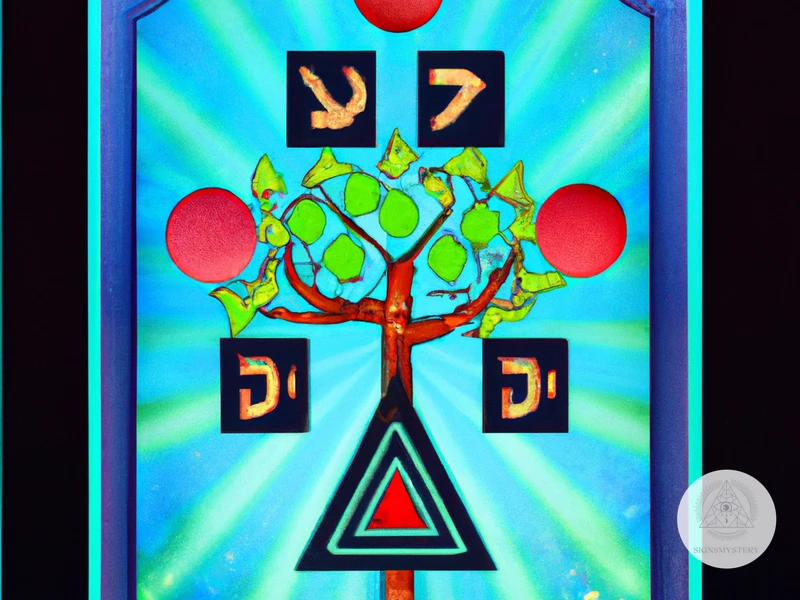
As we delve deeper into the world of tarot, the influence of Kabbalah becomes increasingly apparent. It’s fascinating to explore how the intricate system of Jewish mysticism has played a significant role in shaping the tarot as we know it today. From the symbolism within the cards themselves to the way in which we interpret them during readings, the Kabbalistic influence is both profound and complex. Let’s unravel the connection between Kabbalah and tarot, and discover how this ancient wisdom has made its mark on the world of divination.
The Major Arcana and Kabbalistic Sefirot
As we delve deeper into the connection between Kabbalah and tarot, we must examine the Major Arcana and their association with the Kabbalistic Sefirot. The Sefirot are ten attributes or emanations in Kabbalah that represent the different aspects of God and the universe. Each Sefirot has its own unique qualities and together they form a cohesive and interconnected system.
The Fool – Kether: The Fool card in the tarot deck is often associated with new beginnings, spontaneity, and taking a leap of faith. In Kabbalah, Kether is known as the crown and represents the highest level of consciousness and divinity.
The Magician – Binah: The Magician is a card that represents manifestation and the power of manifestation. In Kabbalah, Binah is associated with the power of creation and represents the divine feminine.
The High Priestess – Chokmah: The High Priestess is associated with intuition, secrets, and the power of the subconscious mind. In Kabbalah, Chokmah represents the divine masculine and the energy of creation.
The Empress – Chesed: The Empress is a card that represents fertility, abundance, and nurturing. In Kabbalah, Chesed represents mercy and is associated with the element of water.
The Emperor – Geburah: The Emperor is associated with authority, structure, and control. In Kabbalah, Geburah represents power and strength and is associated with the element of fire.
The Hierophant – Tiphareth: The Hierophant is a card that represents tradition, spiritual teachings, and inner guidance. In Kabbalah, Tiphareth represents beauty and harmony and is associated with the Sun.
The Lovers – Netzach: The Lovers card in the tarot represents love, relationships, and unity. In Kabbalah, Netzach represents victory and is associated with the planet Venus.
The Chariot – Hod: The Chariot represents drive, determination, and success. In Kabbalah, Hod represents manifestation and the power of language.
Strength – Yesod: Strength represents inner strength, courage, and the power of the will. In Kabbalah, Yesod represents the foundation and is associated with the Moon.
The Hermit – Malkuth: The Hermit card represents introspection, solitude, and self-reflection. In Kabbalah, Malkuth represents the physical world and is associated with the element of earth.
Understanding the connection between these tarot cards and their corresponding Sefirot can deepen your understanding of the tarot and Kabbalah. By incorporating this knowledge into your tarot practice, you may gain further insight and guidance from the cards.
The Four Suits of The Minor Arcana and The Four Worlds of Kabbalah
The Minor Arcana of traditional tarot decks consists of four suits: Swords, Cups, Wands, and Pentacles. Each of these suits is associated with a specific element and has its own unique symbolism. Interestingly, these four suits can also be connected to the four worlds of Kabbalah, known as the Atziluth, Beriah, Yetzirah, and Assiah.
The Swords, associated with the element of Air, represent the realm of thought and intellect. In Kabbalah, this is the world of Atziluth, which represents the highest level of existence, where everything is one with the divine. The Swords can be seen as the manifestation of this divine wisdom in the physical realm.
The Cups, associated with the element of Water, represent emotions, feelings, and intuition. In Kabbalah, this is the world of Beriah, which is often associated with the soul and spiritual enlightenment. The Cups can be seen as the vessel for this spiritual enlightenment to flow through into the physical world.
The Wands, associated with the element of Fire, represent action, passion, and creativity. In Kabbalah, this is the world of Yetzirah, often associated with the realm of angels and the astral plane. The Wands can be seen as the manifestation of this divine inspiration in the physical world.
Finally, the Pentacles, associated with the element of Earth, represent the material realm, including possessions, resources, and the physical body. In Kabbalah, this is the world of Assiah, which represents the physical world and our connection to it. The Pentacles can be seen as the manifestation of the divine on the material plane.
The connection between the four suits and the four worlds of Kabbalah provides a deeper understanding of the symbolism and meaning behind each of the cards in the Minor Arcana. By studying and meditating on the meaning of each suit and its corresponding world, one can gain a deeper understanding of their own spiritual journey and the world around them.
Important to note: It is worth mentioning that not all tarot decks follow this exact correspondence between the suits and the four worlds of Kabbalah, and some may have slightly different interpretations or correspondences. However, the overall influence of Kabbalah on tarot cannot be denied, and the connection between the four suits and the four worlds is a significant aspect of this influence.
Kabbalistic Readings with Tarot Decks
When it comes to using tarot decks for divination and self-discovery, some practitioners choose to incorporate Kabbalistic teachings into their readings. By doing so, they can gain a deeper understanding of the mystical nature of tarot and the interconnectedness of all things.
One way to use Kabbalah in tarot readings is to focus on the concept of the tree of life. In Kabbalah, the tree of life is a visual representation of the 10 Sefirot, or divine emanations, that make up the universe. Each Sefirah represents a different aspect of creation, such as wisdom or compassion, and is linked to a corresponding tarot card.
For example, the first Sefirah, Keter, represents divine will and pure consciousness. This is reflected in the tarot card The Fool, which is often associated with new beginnings and a sense of childlike wonder.
Another way to use Kabbalistic teachings in tarot readings is to consider the four worlds of Kabbalah. These four worlds represent different levels of reality,
Subscribe to Our Newsletter
Sign up to receive the latest news and updates.
The world of Assiah, the physical world, is associated with pentacles or coins. This suit often deals with material wealth and practical matters, such as career or finances.
The world of Yetzirah, the world of formation, is associated with swords. This suit is associated with the intellect, decision-making, and clarity of thought.
The world of Briah, the world of creation, is associated with cups or chalices. This suit is associated with emotions, relationships, and the nurturing of the soul.
The world of Atzilut, the world of emanation, is associated with wands or rods. This suit represents energy, action, and passion.
By understanding these correspondences, tarot readers can gain a deeper insight into the interconnectedness of all things and the ways in which different aspects of our lives affect each other.
It is important to note that incorporating Kabbalah into tarot readings is a personal choice and does not necessarily need to be done in order to use tarot decks effectively. However, for those practitioners who feel drawn to the mystical teachings of Kabbalah, these correspondences can provide a rich and layered approach to tarot readings.
Popular Tarot Decks with Kabbalistic Influences
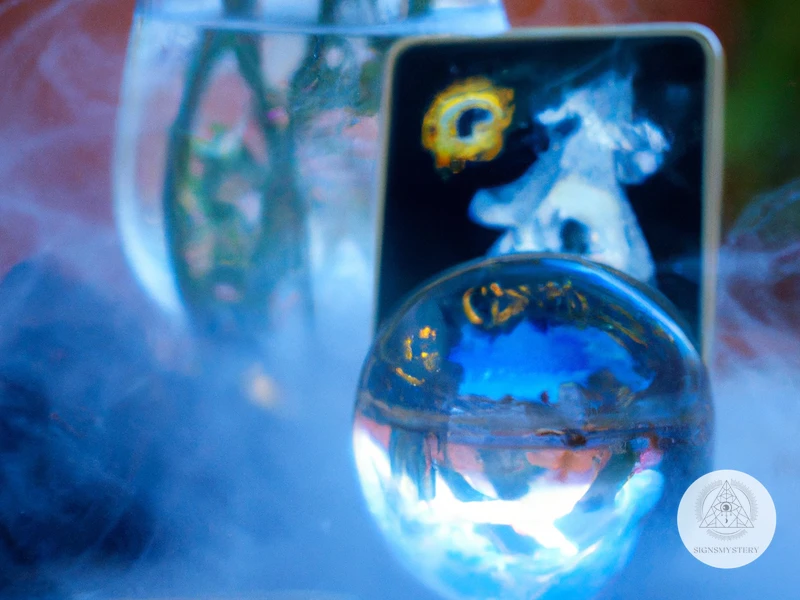
For those interested in exploring the interplay between Kabbalah and tarot, the market offers a range of decks that incorporate these two disciplines. These decks fuse the rich symbolism of both Kabbalah and tarot, creating a harmonious union that can enhance one’s understanding of both practices. In this section, we’ll delve into a few popular tarot decks that have been influenced by Kabbalistic teachings. These decks are unique in their interpretation of the tarot’s archetypes and often come with helpful guidebooks that explore the Kabbalistic influences embedded in each card. Let’s dive in and explore the possibilities that these Kabbalistic tarot decks have to offer.
The Rider-Waite Deck
One of the most popular Tarot decks with Kabbalistic influences is the Rider-Waite deck, also known as the Rider-Waite-Smith deck. This deck was created by Arthur Edward Waite, a British occultist and poet, and illustrated by Pamela Colman Smith, an artist and member of the Hermetic Order of the Golden Dawn.
The Rider-Waite deck was first published in 1910 and quickly became one of the most widely used Tarot decks in the English-speaking world. It is still popular today, and many Tarot readers consider it to be one of the best decks for beginners due to its clear imagery and symbolism.
The Major Arcana of the Rider-Waite deck reflects Kabbalistic symbolism in several ways. For example, the Fool card is associated with the first Sefirah, Kether, which represents the divine spark of creation. The Wheel of Fortune card reflects the concept of the Sefirah of Yesod, which represents the balance between the physical and spiritual realms.
The Minor Arcana of the Rider-Waite deck also reflects Kabbalistic influences. Each suit (Wands, Cups, Swords, and Pentacles) represents one of the four elements (Fire, Water, Air, and Earth) and corresponds to one of the four Worlds of Kabbalah (Atziluth, Briah, Yetzirah, and Assiah). The cards within each suit also depict themes and symbols that relate to their corresponding element.
The Rider-Waite deck also includes a number of cards that depict Kabbalistic symbolism more explicitly. For example, the Hermit card portrays an old man with a lantern, representing the concept of inner reflection and enlightenment. The Tower card depicts a tower being struck by lightning, which represents the breakdown of old systems and beliefs to make way for new growth and change.
Incorporating Kabbalistic teachings and interpretations with the Rider-Waite deck can add depth and insight to Tarot readings. For example, focusing on the Sefirot associated with each card can provide a greater understanding of the card’s meaning and how it relates to the querent’s situation.
The Rider-Waite deck is a highly influential Tarot deck that reflects and incorporates Kabbalistic teachings in its symbolism and imagery. Its pervasive use and popularity make it an excellent tool for incorporating Kabbalah into one’s Tarot practice.
| Rider-Waite Deck |
|---|
| – Created by Arthur Edward Waite and illustrated by Pamela Colman Smith |
| – Considered one of the best decks for beginners |
| – Reflects Kabbalistic symbolism in the Major and Minor Arcana |
| – Each suit corresponds to one of the four Worlds of Kabbalah |
| – Includes cards that explicitly depict Kabbalistic concepts |
The Thoth Deck
The Thoth Tarot deck, also known as the Crowley-Harris Thoth Tarot, is one of the most famous and complex tarot decks in existence. It was created by the infamous occultist and magician, Aleister Crowley, and painted by Lady Frieda Harris. The deck was first published in 1969, long after Crowley’s death, and has since become a staple of modern tarot practice. It is notable for its striking images, rich symbolism, and deep kabbalistic influences.
The Thoth deck is known for its unorthodox interpretations of the traditional tarot cards. Crowley’s extensive knowledge of occultism and kabbalah heavily influenced the deck, and many of the cards feature obscure and esoteric references. The deck also incorporates elements from different mythologies, including Egyptian, Greek, and Hindu.
One of the most significant features of the Thoth deck is its emphasis on the three levels of kabbalistic understanding – the mundane or physical, the intellectual or mental, and the spiritual or divine. As such, the cards of the Major Arcana represent different stages in the journey towards enlightenment.
The table below shows some of the Major Arcana cards in the Thoth deck and their corresponding kabbalistic attributions:
| Major Arcana Card | Kabbalistic Attribution |
|:————-:|:————-:|
| The Fool | The 11th Path |
| The Magus | The 12th Path |
| The Priestess | The 13th Path |
| The Empress | The 14th Path |
Each of these cards is also associated with a specific Hebrew letter, planetary influence, and alchemical symbol, further emphasizing the deck’s kabbalistic influences.
The Minor Arcana cards in the Thoth deck also have strong kabbalistic associations, with each suit representing one of the four elements and one of the four worlds of kabbalah.
The Thoth Tarot deck is a highly complex and deeply spiritual tool that requires a dedicated study and understanding of kabbalistic principles. However, for those who are drawn to its mystical and esoteric symbolism, it can be an incredibly powerful tool for personal growth and self-discovery.
How to Incorporate Kabbalistic Teachings in Your Tarot Practice
For those interested in incorporating Kabbalistic teachings into their Tarot practice, there are various approaches that can be taken. One option is to study the Tree of Life and its corresponding Sefirot, and use this knowledge to interpret the Major Arcana cards in a Kabbalistic context. Consider using the Hierophant card, which relates to the Sefirah of Chokmah, as an example. Chokmah represents wisdom and the masculine aspect of the divine. When interpreting this card, think about how it relates to wisdom and the divine masculine, and how these concepts might be relevant to your question or reading.
Another approach is to explore the Four Worlds of Kabbalah and how they relate to the Minor Arcana suits. For example, the Cups suit can be associated with the World of Briah, which relates to creation and emotions. When reading with this suit, think about how emotions and creativity interplay and how they relate to your question or situation.
It’s important to note that incorporating Kabbalistic teachings into your Tarot practice should not be done blindly, but with a deep understanding and respect for the tradition. Take the time to study and learn from reputable sources, and always trust your intuition when interpreting the cards.
Lastly, don’t forget that the ultimate goal of Tarot is to gain insight and wisdom, and incorporating Kabbalistic teachings can be a powerful tool in achieving this goal. Whether you choose to study the Sefirot, the Four Worlds, or simply incorporate Kabbalistic symbolism and imagery into your readings, the potential for deep insight and personal growth is limitless.
Conclusion
In conclusion, the presence of Kabbalah in traditional Tarot decks has been a significant influence on the history and interpretation of these mystical cards. Through the use of Kabbalistic symbolism, Tarot readers can deepen their understanding of the cards and the interconnectedness of the universe.
Exploring the relationship between Kabbalah and Tarot offers an opportunity to dive into the ancient wisdom of Jewish mysticism and gain a new perspective on the spiritual dimensions of Tarot. The integration of Kabbalistic teachings in Tarot practice expands our awareness of the connections between the physical and spiritual realms and provides guidance on our spiritual journeys.
As we have seen, Kabbalistic influences have shaped some of the most popular Tarot decks, including the Rider-Waite and Thoth decks. These decks are not only visually stunning but also powerful tools for personal growth and introspection.
By incorporating Kabbalistic teachings into Tarot readings, we can unlock a deeper level of understanding and tap into the universal energy that flows through us all. Whether you are a seasoned Tarot reader or just starting, the use of Kabbalistic symbolism can enhance your connection to the spiritual world and offer insights into your life’s path.
In the end, the presence of Kabbalah in traditional Tarot decks serves as a reminder of the timeless pursuit of enlightenment and the quest for a deeper understanding of the universe. The integration of these two mystical traditions opens up a vast realm of knowledge and deepens our spiritual sense of self. By using Tarot cards as a gateway to Kabbalistic teachings, we can embrace a more meaningful and enriched life.
Frequently Asked Questions
Can Tarot and Kabbalah be used together?
Yes, absolutely! In fact, Kabbalah has had a significant influence on traditional tarot decks.
What is the major difference between Kabbalah and Tarot?
Kabbalah is a Jewish mystical tradition, while tarot is a form of divination using a deck of cards.
How does Kabbalah influence the Major Arcana?
Kabbalah’s sefirot, or ten emanations, are directly represented in the Major Arcana cards.
What is the significance of the four suits of the Minor Arcana in Kabbalah?
The four suits correspond to the four worlds of Kabbalah, namely Atziluth, Briah, Yetzirah, and Assiah.
What is the Rider-Waite tarot deck?
The Rider-Waite deck is one of the most popular tarot decks in the world, first published in 1910.
How did the creator of the Thoth deck incorporate Kabbalah?
Aleister Crowley, the creator of the Thoth deck, was a student of Kabbalah and incorporated its teachings into the deck.
What is a Kabbalistic reading of tarot cards?
A Kabbalistic reading takes into account the correspondences between tarot and Kabbalah in order to provide deeper insight into a situation or question.
Can anyone learn to use tarot and Kabbalah together?
Yes, with practice and study, anyone can incorporate Kabbalistic teachings into their tarot practice.
What are some other tarot decks that incorporate Kabbalistic teachings?
The Hermetic Kabbalah tarot and the Golden Dawn Magical Tarot are both decks that specifically incorporate Kabbalistic teachings.
What can incorporating Kabbalistic teachings into tarot practice bring?
Incorporating Kabbalistic teachings can bring a deeper understanding of the spiritual and mystical aspects of tarot, and can provide more depth in readings.



